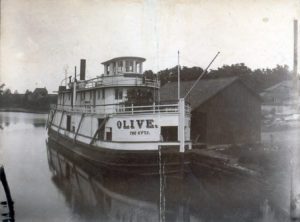by James Clothier
When the Town of Kemptville celebrated its 150th anniversary in 1957, the Kemptville Women’s Institute collected a great deal of information about the town’s history. The following article was part of that collection and deals with the wharf that existed at the bridge on Bridge Street.
In 1872, my grandfather, Ambrose Clothier, bought from the Rev. Henry Shaler two acres of land bordering on the river and extending from the bridge southward on the east side of Bridge Street. On this property, he built a mill, which served as a saw mill, a planing mill, and a shingle mill. I have only a vague recollection of it, for it was destroyed by fire, probably in 1877.
My father moved his small family in June 1878 from the brick house known at present as the McKeen Hotel [later the Kemptville Hotel] to the house in which my sister Mrs. Boyle, and I now live. At that time, a new mill had taken the place of the one recently burnt.
A wharf had been built at some time between 1872 and 1878. It contained a coal shed on the end near the bridge. A steamboat, probably the “Olive”, was making weekly trips from Montréal. The freight that it brought was deposited on the wharf and drawn away at once by the owners or by carters. Sometimes so many bags of coarse salt were unloaded that they remained for one or more days, piled and covered by tarpaulins, and providing a playing area for the group of boys that always gathered.

In 1887, or soon after, my father built a freight shed on the wharf and collected for the boats their charges, usually on goods brought in, but in some cases on freight taken out. He also made a small charge for a wharfage on goods left for shipment.
With the building of the freight sheds came the recording of the steamers and their cargoes. In 1888, three different boats made regular trips once a week; in 1889 only two did this, but in 1890, the third resumed its run. All told, between 1888 and 1925, nine boats assisted in freight carrying. Several of these were equipped for passenger service also. During this period, the freight charges alone on goods brought in amounted to $27,201.
How much money the boats collected on goods carried from here to other parts, I cannot say, as the freight charges where, in most cases, paid at the points of destination. For a season or two, many tons of potatoes were sent out, by Mr. S. T. Mills. Also, from 1899 till 1904, the Kemptville Milling Company, comprising Alonzo Bowen and Sons, shipped 407 tons of flour and feed. In 1892, the cheese factories of this district began sending their product by boat to Montréal. From this date till 1925, when motor trucks replaced boats, at least 41,000 boxes of cheese were carried from here, by the “Olive” and its successor the “Ottawan”.
In the early years of this trade, a box of cheese weighed about 48 pounds; later it weighed from 80 to 98 lbs. Allowing an average of 66 lbs. to the box and the price of 11¢ a lb., we find the value of the 41,000 boxes to be $297,660.
As a shipping point, the wharf became unnecessary when the boats withdrew from business in 1925. At present, it is barer than it was in 1878. The somewhat dilapidated coal shed of that date was removed to make room for the freight shed. The latter remained in place, usually empty, until a few years ago when it was moved to another part of the property and used for storage purposes.
Spring floods and the weather have damaged the wharf in the course of the years. However, it is still used in many ways. Men wash their cars on it, boys and girls swim from it, men and boys cast trolling lines there hour after hour, motorboats are launched or are taken from the water at its edges, sleighs and cars cross over it to travel on the ice in winter, and women and children relax upon it on the hot days of summer.
In the more than 60 years that have passed since James Clothier wrote down the story of the Wharf, the location has changed even more. There is little there now to indicate what a busy centre of business existed on the river in those olden days.






Very interesting nice to know about Kemptville’s past. Thank you
Interesting story.
Wish the wharf was still there and boats could dock there. The Olive looked really good!
Did the wharf used to be called Governors Wharf?